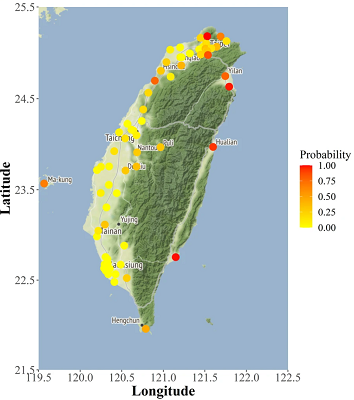利用貝式空間存活分析
| 蘇佩芳1Pei-Fang Su,謝妃琪1Fei-Ci Sie,楊珺婷2Chun-Ting Yang,茆玉麟1Yu-Lin Mau,郭士偵3Shihchen Kuo,歐凰姿2Huang-Tz Ou | |
|
1國立成功大學統計學系Department of Statistics, National Cheng Kung University, Tainan, Taiwan 2國立成功大學藥學系,成大醫院藥劑部Department of Pharmacy, College of Medicine, National Cheng Kung University, Tainan, Taiwan 3美國密西根大學安娜堡分校,新陳代謝與內分泌科,內科部Division of Metabolism, Endocrinology & Diabetes, Department of Internal Medicine, University of Michigan Medical School, Ann Arbor, MI, USA |
|
| pfsu@ncku.edu.tw | |
| Environmental Health. 19(1):110. (2020) | |
|
關鍵字:存活時間, 空間相關, 貝氏方法, 心血管疾病, 第二型糖尿病 Key words:Time-to-event, survival, spatial correlation, Bayesian approach, cardiovascular disease, Type 2 diabetes |
|
|
該研究整合健保資料庫以及環保署空氣品質監測網大數據資料,蒐集2,072位在2009年開始進入二線用藥的第二型糖尿病患者,並持續地追蹤至2013底結束的長期資料。本研究主要分析這群患者第一次心血管疾病發生的存活時間或設限時間以及連結患者的用藥史、基本資料之間等關係。 研究主要貢獻是加入環境污染風險因子,即全臺灣76個空氣品質監測站的八項空氣品質指標,包括細懸浮微粒(PM2.5)、粒徑小於等於10微米懸浮微粒(PM10)、二氧化硫(SO2)、一氧化氮(NO)、二氧化氮(NO2)、氮氧化物(NOX)、一氧化碳(CO)與臭氧(O3)等。本研究精確採用貝式空間存活分析可呈現時間與空間的大數據分布,該模型的好處是可同時考慮台灣的地理空間分布狀況以及心血管疾病發作時間。最後發現PM2.5和SO2是顯著影響心血管疾病的危險因子。(圖一呈現利用貝式空間存活分析模型所計算台灣地區心血管疾病的預測風險超越機率)。 This is a collaboration with researchers from NCKU Hospital pharmacy department. The Big Data Center from NCKU hospital integrates the work of data analyses based on the dataset of type 2 diabetes. Taiwan’s national-level health claims and air pollution databases were actually utilized in this research. There were 2072 diabetic patients included in analyses. We assessed the association between air pollution and cardiovascular diseases (CVDs) in type 2 diabetes through a Bayesian spatial survival approach. In particular, the air pollution information was collected from 76 monitoring stations over different geographic areas. The real-time concentrations of eight critical air pollutants, particulate matter (PM2.5, PM10), nitric oxide (NO, NOx), nitrogen dioxide (NO2), carbon monoxide (CO), sulfur dioxide (SO2), and ozone (O3), are routinely measured once every hour. Overall, PM2.5 and SO2 were significant CVD risk factors in our model. Against traditional non-spatial analyses, our Bayesian spatial survival model enhances the assessment precision for environmental research with spatial survival data to reveal significant adverse cardiovascular effects of air pollution among vulnerable diabetic patients. (Figure 1 shows the predicted risk-exceedance probabilities of cardiovascular diseases for individual geographic areas.) |
|
|
圖(一)呈現利用貝式空間存活分析模型所計算台灣地區心血管疾病的預測風險超越機率 |


 本
本